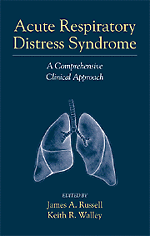Book contents
- Frontmatter
- Contributors
- Contents
- Preface
- Introduction
- 1 Overview, Clinical Evaluation, and Chest Radiology of ARDS
- 2 The Epidemiology of ARDS
- 3 The Pathology of ARDS
- 4 Cytokine -Induced Mechanisms of Acute Lung Injury Leading to ARDS
- 5 Pulmonary Pathophysiohgy in ARDS
- 6 Cardiovascular Management of ARDS
- 7 Mechanical Ventilation
- 8 Respiratory Muscles and Liberation from Mechanical Ventilation
- 9 Clinical Assessment and Total Patient Care
- 10 ARDS: Innovative Therapy
- 11 Nosocomial Pneumonia in ARDS
- 12 Resolution and Repair of Acute Lung Injury
- 13 Multiple System Organ Failure
- 14 Outcome and Long-Term Care of ARDS
- Index
12 - Resolution and Repair of Acute Lung Injury
Published online by Cambridge University Press: 05 October 2010
- Frontmatter
- Contributors
- Contents
- Preface
- Introduction
- 1 Overview, Clinical Evaluation, and Chest Radiology of ARDS
- 2 The Epidemiology of ARDS
- 3 The Pathology of ARDS
- 4 Cytokine -Induced Mechanisms of Acute Lung Injury Leading to ARDS
- 5 Pulmonary Pathophysiohgy in ARDS
- 6 Cardiovascular Management of ARDS
- 7 Mechanical Ventilation
- 8 Respiratory Muscles and Liberation from Mechanical Ventilation
- 9 Clinical Assessment and Total Patient Care
- 10 ARDS: Innovative Therapy
- 11 Nosocomial Pneumonia in ARDS
- 12 Resolution and Repair of Acute Lung Injury
- 13 Multiple System Organ Failure
- 14 Outcome and Long-Term Care of ARDS
- Index
Summary
Introduction
Successful recovery of lung function after acute lung injury requires that the repair process occur in an orderly and controlled sequence similar to that of other injured tissues. First, the excess alveolar fluid and soluble proteins must be removed from the airspaces. Second, the excess soluble and insoluble proteins must be cleared from the alveoli. Third, alveolar epithelial type II cells must repopulate the denuded epithelial barrier. Fourth, the edematous and fibrotic interstitium must shrink and reconstitute its normal matrix. Fifth, the injured and obstructed endothelium must be recanalized to restore normal blood flow to the lung. Sixth, all of the nonessential cells that participated in the repair process must die and their cellular debris must be cleared. Failure of any one of these processes will result in persistent lung injury with fibrosing alveolitis and nonresolving respiratory failure.
This chapter reviews what is known about the recovery of normal lung function after acute lung injury. The first section reviews the mechanisms responsible for removal of alveolar edema fluid. The second section discusses the fibrosing alveolitis that develops as a response to acute lung injury with an emphasis on the role of extracellular matrix proteins in this process. The third section describes the potential contribution of growth factors in remodeling of the vascular endothelium, the interstitium, and the alveolar epithelial barrier. The clinical manifestations and significance of these recovery phases is considered as well.
- Type
- Chapter
- Information
- Acute Respiratory Distress SyndromeA Comprehensive Clinical Approach, pp. 275 - 303Publisher: Cambridge University PressPrint publication year: 1999



